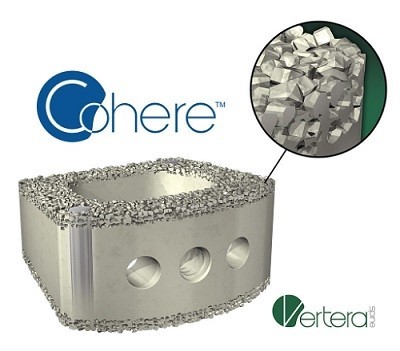
Vertera Spine has announced the first wave of implantations with the Cohere cervical interbody fusion system. Cohere features the company’s patented porous PEEK (polyether ether ketone) Scoria biomaterial technology.
According to a press release, Cohere is the first device in clinical use to be manufactured entirely out of PEEK, and to be porous.
Intended for use in anterior cervical fusion procedures to treat complex, single or multi-level spinal pathologies, Cohere introduces a porous osteoconductive environment to bone without compromising the mechanical integrity of the implant, according to the release.
Multiple studies report the advantages of adding porosity over two-dimensional roughness to implants to improve osseointegration. PEEK Scoria’s three-dimensional porous structure has been designed to optimise bone formation on the cellular level as well as effectively form a strong interface with bone. Since the implant is made entirely out of PEEK polymer, Cohere produces no medical imaging artefacts.
To date, Cohere has been implanted at a select number of premier orthopaedic and spine surgical sites, including Rush University in Chicago, USA. Phillips, a professor at Rush University, was one of the first surgeons to use Cohere in a cervical fusion surgery.
“I think the porosity of the Cohere PEEK interbody device will allow for more rapid osseointegration seen with textured surface devices, while at the same time allowing for radiographic visualisation of the fusion,” says Phillips. “From the substantial research compiled, we have learned that
Scoria’s porosity promotes implant osseointegration, with the surface characteristics being more important than the implant material.”
While PEEK fusion devices are usually treated with metal coatings that can delaminate during and after surgery, porous PEEK Scoria is grown directly from the solid PEEK implant through a patented processing method. According to the release, this allows implants to exhibit twice the shear strength of vertebral trabecular bone.
“Using the Cohere implant was a seamless transition from the allograft cage I previously used. I have been impressed with its easy insertion as well as the durability of the porous PEEK during implantation,” says Richard Fessler, also professor at Rush University.
Several of the first surgeries have also been performed in the state of Georgia, USA, near Vertera Spine’s headquarters in Atlanta. James L Chappuis, chief surgeon at SpineCenterAtlanta in Atlanta, USA, has implanted over a dozen Cohere implants to date.
“I have been looking forward to adopting Cohere into my clinical practice. Vertera Spine’s porous PEEK Scoria addresses the challenges of current PEEK cages that are bioinert as well as metal cages that make it difficult to assess fusion on X-ray and CT,” says Chappius.
J Kenneth Burkus, another COHERE clinical user from the Hughston Clinic in Columbus, USA, says, “The ability of Cohere to osseointegrate and not produce any imaging artefacts is unprecedented for spinal fusion devices. What convinced me to use this device is the fact that the porous PEEK implant is made from one material and does not have to rely on any coatings to provide osteoconductivity,”













